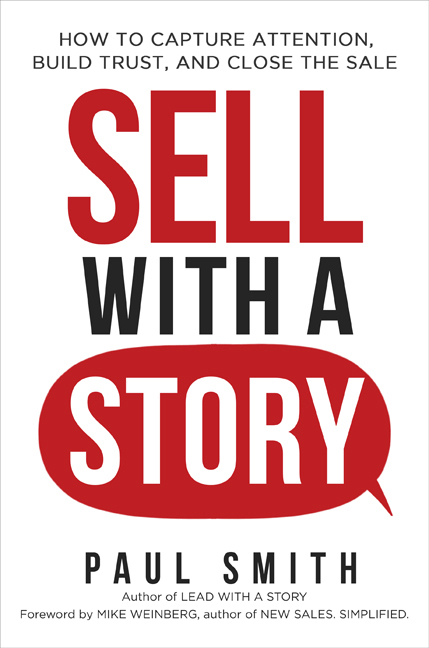Podcast (sell-with-a-story-series1): Play in new window | Download | Embed
Subscribe: RSS
{#25 in a series of the 25 most useful sales stories from Sell with a Story, by Paul Smith}

One of the most productive uses of storytelling in sales isn’t found in a story you tell to the buyer, a story the buyer tells you, or even a story that you tell to yourself. It’s a story that you craft for the benefit of other salespeople who work at your company. And it tells the story of the successful sale you just closed or the unsuccessful one you just failed to close. The purpose is to capture the wisdom you just gained in the call for your boss, your peers, or the next generation of salespeople calling on that customer.
We all know those wise old sales gurus who’ve been around and seen it all. We love hearing their “war stories” about what worked and what didn’t work. Well, you don’t have to have been around for 40 years to remember a few great war stories if you capture your stories as they happen.
One of my favorite examples comes from a guy named Steve Blair from his days as a salesperson for a major confectionary company.
The Valentine’s Day Box of Chocolates

In the summer of 2010, when Steve was about a year into the role, he was calling on the buyer at a major drugstore chain. The buyer, let’s call him David, was legendary in the business. Once you had his ear and earned his trust, you had it forever. But getting that trust was difficult. And neither Steve nor anyone at his company had earned it yet.
At one point, Steve and his boss (the CEO of the company) rented a suite at a major league baseball field and invited David and his boss to a game. Their general purpose was to get to know their prospects a little better. But Steve also had a specific sales objective: get David to agree to carry at least one of their boxes of heart-shaped chocolates for Valentine’s Day.
Steve had been trying unsuccessfully for weeks to make that sale. David’s objection each time was that he thought the price per ounce of chocolate was too high. Said another way, he thought there just wasn’t enough chocolate for the price. Steve’s response each time was that Valentine’s Day chocolates are a gift. The person who receives the chocolate will appreciate the gift regardless of how much chocolate is in it.
Steve was hoping he could finally get David to see things his way during the game. Somewhere around the sixth inning, Steve saw his opportunity. He noticed that the server in the suite was a 20-something female—exactly the demographic profile of someone who might be on the receiving end of a box of Valentine’s Day chocolates. Steve thought David might understand his position if he could hear for himself how much a young woman would appreciate one of these gifts.
The next time she came through the suite, Steve pulled her over to ask her a question. He took out a sample of one of the boxes and held it in front of her. Making sure he had David’s attention, he said to her, “What would you say if your husband or boyfriend gave you this for Valentine’s Day?” Of course, Steve couldn’t be sure how she’d respond. But who doesn’t like a free box of chocolates?
The server opened up the box, looked inside, and then said,
Well, the first thing I’d probably say is ‘Where’s the rest of the chocolate?’
David looked over at Steve and said simply, “Conversation over.”
Steve was devastated. He thanked the server and sat silently for the remaining three innings of the game, knowing that his ill-conceived tactic to close the sale had not only failed but had actually backfired. David now had even more reason to not buy those chocolates, and he didn’t for more than a year, until Steve had left for another job. The lesson Steve learned that day is that it’s risky to employ a sales tactic when you can’t predict the outcome.
The Lesson
Today, Steve is Vice President of People & Culture at The Harvest Group, a sales and marketing consultancy that specializes in helping consumer packaged goods companies sell their products to national retail buyers like David. Steve very generously shares this embarrassing failure story, as well as his many successes, with his coworkers. The reason, of course, is so that they can all benefit from the lessons and therefore make even more successful sales for their clients.
Not every one of your sales calls will result in a story this worthy of passing along. But many will. Don’t let time rob them from your memory, and don’t let your pride keep them from being shared. Write them down and share them as quickly and regularly as you would your expense report.
Source: Sell with a Story: How to Capture Attention, Build Trust, and Close the Sale, by Paul Smith.
Use these links to subscribe to this podcast on iTunes or Stitcher, or Podbean.

Paul Smith is one of the world’s leading experts on business storytelling, a keynote speaker, and bestselling author.
Connect with him via email here. Follow him on Facebook and LinkedIn.



